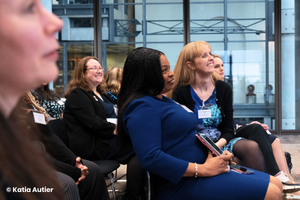Kevin Poulter is a partner in the employment team at Freeths LLP, where he advises businesses, charities and employees on a broad range of employment issues including employee rights, contracts and workplace disputes. Kevin regularly appears in the press and broadcast media to comment on workplace matters and employment law and is a successful facilitator of training sessions, seminars and roundtable events.

“When we talk about inclusivity, what does it mean in a day-to-day practice? It means bringing everybody with us, bringing people into the tent because they deserve to be there (and getting a bigger tent if needed), but also because we need them to be there.”
Context
Mandatory gender pay gap reporting is creating something around it, but possibly doesn’t go far enough. We’ve talked about board diversity with Charlie Godolphin’s reassuring insights from the new FTSE Women Leaders Review report.

We have the option to introduce voluntary ethnicity pay gap reporting in our organisations, with some guidelines around how that reporting should be carried out, but it’s voluntary and will likely only affect those who are already committed to internal EDI (equity, diversity and inclusion) targets. But what more can we do? And it’s not just about the law. It’s about the cultural pressures arising from all over the place, the impact of Brexit and COVID on the labour market and the commercial realities of a credit crisis, rising taxes and declining town centres.
Bringing people into the tent
When we talk about inclusivity, what does it mean in a day-to-day practice? It means bringing everybody with us, bringing people into the tent because they deserve to be there (and getting a bigger tent if needed), but also because we need them to be there. One of the critical issues for business right now is employee retention.
For anyone who heard the trailer for the Moral Maze on Radio 4 this morning (yes, I listen to Radio 4 in the morning now…) they posed the question of how to get young people into work because, and this is an incredible statistic, 9% of 18-to-24-year-olds not currently in work (but possibly in education) never intend to start working. 9%!
Another statistic for you: a third of 18-to-34-year-olds who returned to work after COVID, after the lockdowns, have gone only into gig work. This is an incredible statistic, from the City and Guilds’ Youth Misspent survey, which is worth a read. It took me by surprise.
What we need to deal with is how we get those people into work. How do we, as employers, but also those working with business, overcome the issues of costs of hiring, as well as the other practical difficulties in hiring and recruitment?
How do we deal with the cost-of-living crisis that people are facing, whilst also dealing with the rising cost of running a business on the other side of things? The only way we can do that is to create workplaces where people feel welcome, and where people want to be for the longer term.
This includes older people. More over-50s are taking early retirement. People going through menopause and not coming back to work. People not going for promotions on the back of it. So, that’s really my starting point.
The M-word
If I say to you ‘Davina McCall’ what do you think of? Streetmate? Big Brother? No … menopause! New Equality and Human Rights Commission guidance around menopause has been produced. A lot of work is being done to drive the political, social, and legal agenda around menopause and this has now become a hot topic in business (no pun was intended).
It’s what people are talking about, so there is now a greater understanding about symptoms. It might not be a protected characteristic under the Equality Act 2010 in and of itself, but some symptoms may provide protection. We can talk about disability discrimination, sex discrimination and age discrimination and we can talk about harassment and victimisation too. And these things do not stand alone. They are intersectional. They can be linked.
Policies and guidance alone are not enough to bring about real change in the workplace. So, what are employers doing about it? In no particular order, here are some suggestions from event attendees on addressing the challenges of menopause in the workplace and how support can be provided:
- Training employees and especially line managers
- Forming support groups and employee network
- Additional resources — literature, podcasts, videos
- Mentoring and reverse-mentoring
- Stakeholder engagement — asking women what they think about it and speaking to those who are affected
- Training GPs on completing Fit Notes, or asking for more information about how support can be provided
- Workplace accommodations like temperature control and ventilation
- Flexible working — understanding that employees might need to change hours of work on a temporary or semi-permanent basis
- Uniform changes or relaxation of rules

These are all great ideas and ones which can be included in policies, but proactive steps are necessary to create an inclusive and supportive workplace.
Employers should also consider how menopause may indirectly impact on employees, for example in menopause-related sickness absence and how that might affect appraisals, pay reviews and bonuses. As with family leave and disability, such absences could be disregarded from review and assessment.
So why are so few employers bringing people together to discuss it? It makes sense to involve people and address any issues and opportunities directly, with those in attendance fearing it was a general discomfort around discussing biology that might be to blame. As one delegate suggested, “Some women don’t want to discuss their period (or their lack of periods) with a 21-year-old manager who’s male.”
Along with training, encouraging and supporting a culture of openness, some of these barriers can be reduced and overcome. But there has to be some intent. When an organisation declares its pride in achieving a 71% success rate in employees completing compulsory training, more needs to be done. From time to time, there should be penalties for those who refuse to engage in positive cultural reform.
Tackling sexual harassment
Very few people are already aware of the Worker Protection (Amendment of Equality Act) Act is coming into force in October 2024, where employers will be required by law to take ‘reasonable steps’ to prevent sexual harassment of employees in the course of their employment (i.e. unwanted conduct of a sexual nature). But what does that actually mean? Unfortunately, on the face of it, this is the Government taking a step back from what the law already requires, namely that an employer must take ‘all reasonable steps’ to prevent such acts of harassment from taking place.
So, what might those reasonable steps look like?
- Up-to-date and regularly reviewed policies
- Regular, compulsory and effective training of staff
- An effective avenue to make a complaint
- Taking each complaint seriously
- Taking disciplinary action when required
Creating a positive culture is in part about raising awareness and having discussions in the workplace about appropriate behaviour without accusing anyone, but making people aware about what can cause sensitivities. Relying on a policy is not enough. As one delegate suggested: “Is it feasible that someone might not know it’s harassment when they’re leaning over you and pressing their groin into your shoulder?”
We will all have heard people claim ‘old school banter’ is OK, but being ‘old school’ is not an excuse. Newer entrants to the workplace may not have the life experience and resilience that comes with it, or the tools available to them to stand up to it and call out bad behaviour. An employer has a duty to intervene and protect its employees, and to hold people accountable.
One of the things which regularly causes me concern is that a blind eye is turned to some employees because they are bringing in the money, they are a senior person, because they know the board, because they’re friends with one of the funders. This is an all too widespread reality still, in 2024, and if that keeps happening, we will never see the issue really being dealt with. But we have to deal with it and kicking it into the grass is now not going to be good enough for the law from October.
One of the audience members explained how they bring in the values of their organisation into HR training because values underpin the culture of the organisation. Absolutely, and employers can recognise the values in equally weighted assessments, appraisals, pay and bonus reviews, not just taking into account how much money are people are bringing in (although we all know that can be important too).
A tick-box approach is not enough
Sometimes a tick box approach is taken to things like training, so someone in HR can say: “We’ve run a positive training session” but actually, on the ground, the reality is very different.
Employment tribunals are pushing back and saying: “No, that’s not good enough. It has to be real. It has to be proactive. And you have to be able to prove it.” They are driving it and, arguably, they’re doing a lot more than Parliament.
So, for now, have confidence in the legal framework, but don’t see it as a platform to build from, not something which must simply by met with the lowest effort required. By working with the law and together with its employees, an organisation can easily improve the diversity of employees in the workplace, but more effort needs to support the sustainable inclusion of those employees. A happy workforce is a loyal workforce and that makes commercial sense too!
Note: The text in this article has been adapted from a presentation at the recent Womanthology Inclusion Thought Leaders’ Event, held at Lloyd’s of London on 28th February 2024.





